How do you create the best influencer marketing campaigns? Influencer marketing campaigns, once confined to niche industries like consumer goods and fashion, have rapidly evolved into the unique marketing strategy of our time. Some years back, a colleague at work tried the new GlowPro Serum from Radiant Skincare, and wow, it was a game-changer for her! Within a week, her skin felt smoother and looked brighter.
For years, she struggled with dullness and uneven texture, but this serum has worked wonders. It’s lightweight, absorbs quickly, and has a subtle, pleasant scent. She said she loved that it’s packed with natural ingredients—no harsh chemicals. She further told me that her morning routine had undergone a serious upgrade. So, if you want to boost your glow, give GlowPro a shot. Trust me, you won’t regret it!
Before I show you how to create the best influencer marketing campaigns, let’s understand what influencer marketing campaigns are.
Key Points
- Influencer marketing campaigns are a social media marketing strategy in which brands collaborate with influencers.
- Different influencer marketing campaigns include Giveaway Contests, Event Activations, Social Media Takeovers, Sponsored Social Posts, Brand Ambassadors, and Pre-release Campaigns.
- Ways to improve influencer marketing campaigns include focusing on relationships, leveraging data-driven Influencer Marketing Platforms, and partnering with micro-influencers and customers.
- To know whether an influencer marketing campaign is successful or not, check out brand awareness, brand engagement, social media growth, and database growth.
- Some of the diverse influencer marketing campaign examples to illustrate this strategy’s range of approaches and creativity are Barbie, Calvin Klein, and Daniel Wellington.
What Is Influencer Marketing Campaigns?
Influencer marketing campaigns are a social media marketing strategy in which brands collaborate with influencers. Great for driving brand awareness, these campaigns capitalize on an influencer’s popularity and social media following, whether big or small.
We can define influencers as trusted content creators with the power to affect how their audience makes purchasing decisions. They also have a significant, well-engaged following in their niche. Influencers can leverage Instagram automation to efficiently endorse or mention products, share their opinions with their audience, and effectively partner with brands.
Let’s take a look at the different types of influencer marketing campaigns.
What Are the Different Types of Influencer Marketing Campaigns?
Influencers are endlessly creative when making social content (that’s their job!), so there are many kinds of influencer campaigns. Still, most fall into a handful of different categories.
The different types of influencer marketing campaigns include:
#1. Giveaway Contests
Giveaways are cost-effective lead generators and branding vehicles. They also entice audience members to share with friends and colleagues.
A good example is the teen-focused fashion brand, Colorful Natalie. It collaborated with Emmy Butcher and eight other micro Instagram influencers to promote its giveaway contest, which offered a chance to win a $100 gift certificate and a pair of Nike Air Jordans.
Note below how the rules are clearly stated. The intent is to tag as many friends as possible to increase one’s chance of winning.
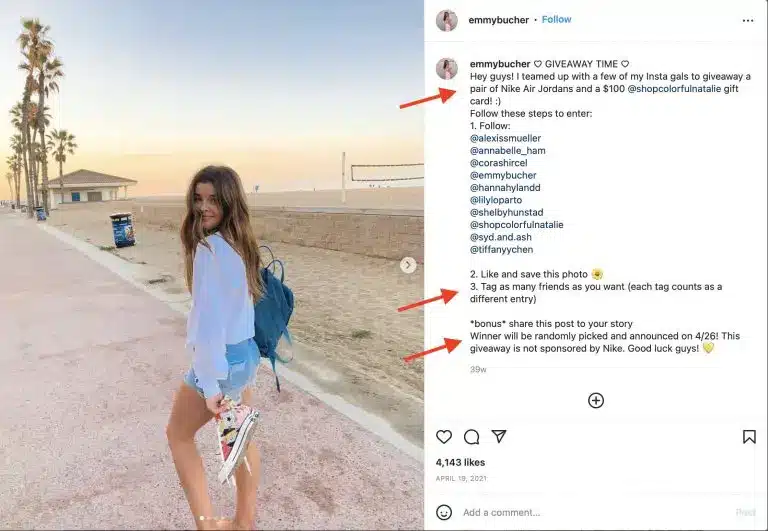
A separate post showcased the Nike shoes. The campaign generated thousands of likes and comments across all nine influencers — 4,200 likes and 700 comments on Butcher’s profile alone. Every participant followed Colorful Natalie’s profile.
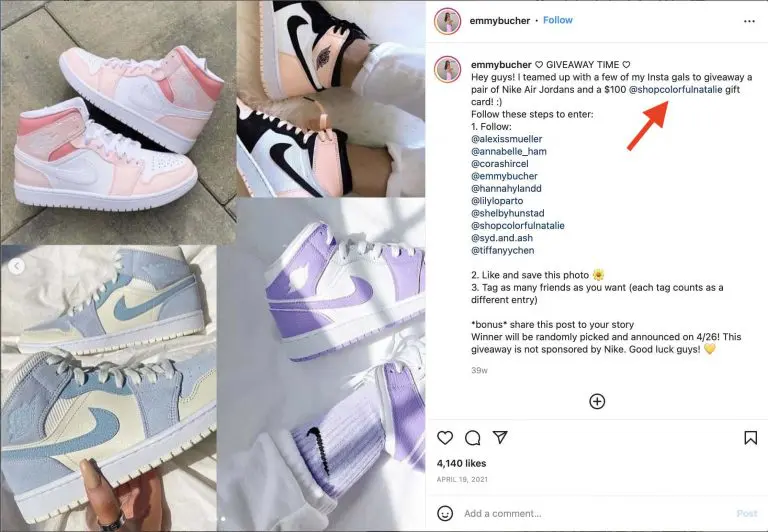
#2. Event Activations
Event activations promote meetups, gatherings, campaigns, and similar. The goal is to partner with influencers who can drive brand awareness and lasting relationships. The right influencers can help an event appear credible, increasing sales afterward.
Revlon’s Mascara Day campaign with Walgreens is a good example. Revlon worked with 32 influencers, including beauty blogger Lynne Cain. Each developed content—text and images—around Revlon’s mascara.
The campaign reportedly generated a 671% lift in Revlon, and Walgreens mentions while driving in-store traffic and unit sales.
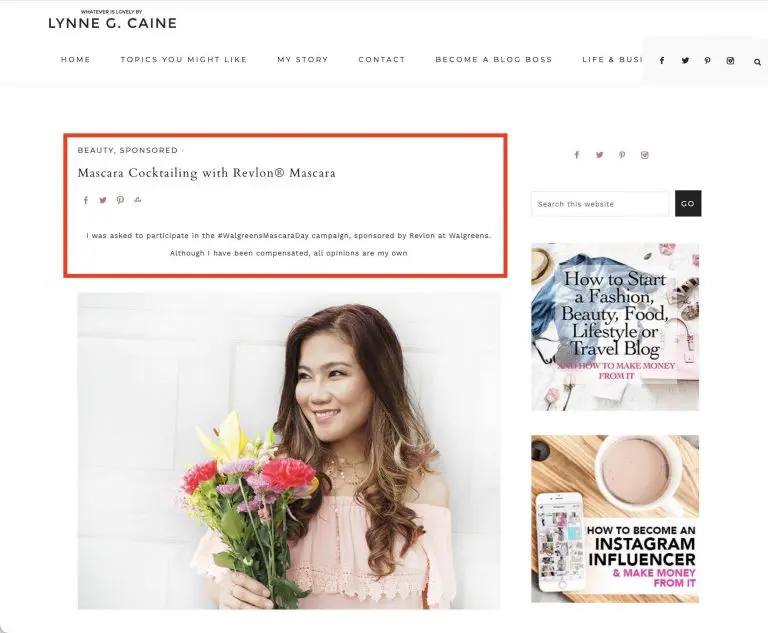
#3. Social Media Takeovers
Social media takeovers allow influencers to “take over” your feed, giving them posting privileges for a set period. This campaign can expose your business to new audiences and drive engagement. The key to a successful social media takeover is influencers with loyal followers.
Apparel retailer Everlane chose Teen Vogue editor Michelle Li to promote its new bootcut jeans. Li is a fashion expert with a dedicated audience that follows Everlane’s Instagram stories about the latest product.
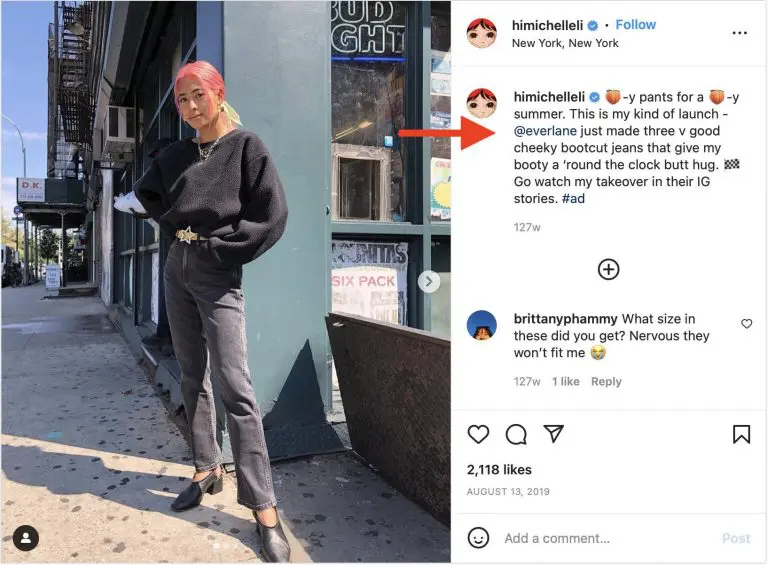
#4. Sponsored Social Posts
A social media post from the right influencer can drive sales and build trust. Look for influencers with high engagement, quality content, and authenticity. For example, check out how Köe, a beverage manufacturer, tapped a health and fitness influencer on Instagram, @joyfullygreen, to build brand awareness and sell the organic Kombucha drink.
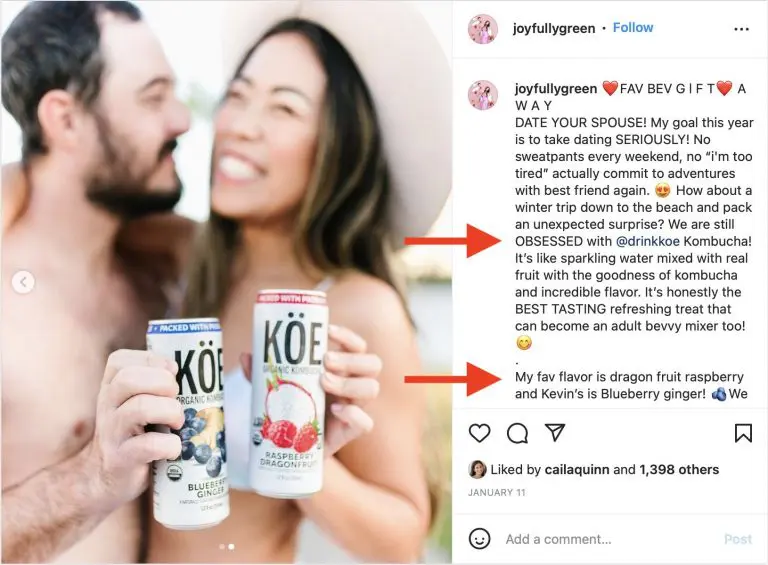
#5. Brand Ambassadors
Brand ambassadors are influencers representing your business and products for an extended period, elevating awareness, trust, and sales. With the exemplary ambassador, the possibilities are seemingly endless.
For example, Gymshark, a fitness-focused apparel company, built an e-commerce empire by recruiting authentic, real-life brand ambassadors passionate about fitness.
Stephanie O’Neil, Gymshark’s head of public relations and brand partnerships, told Fashion and Beauty Monitor, a PR service, “It’s all about being authentic. Most Gymshark ambassadors were once fans and consumers of the brand. Who better to represent the brand than those who love Gymshark?”
Remember that when considering your brand ambassadors.
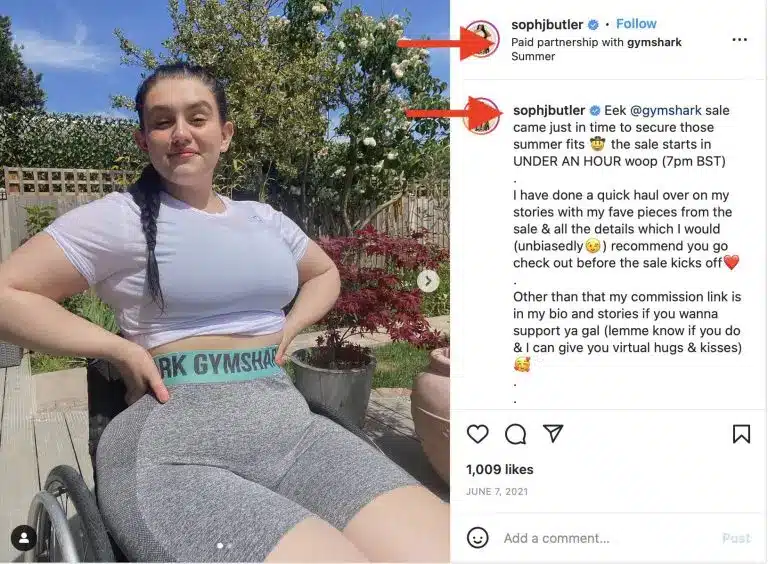
Read also: How Brand Ambassadors Can Help to Grow Your Business
#6. Pre-release Campaigns
Pre-release influencer campaigns show off an upcoming product to build anticipation and buzz, driving a “fear of missing out” mentality. Online apparel brand Vici does this by partnering with dozens of fashion influencers on Instagram. Using their Stories, Vici teases new products before launch and offers influencers’ followers an exclusive discount code to buy
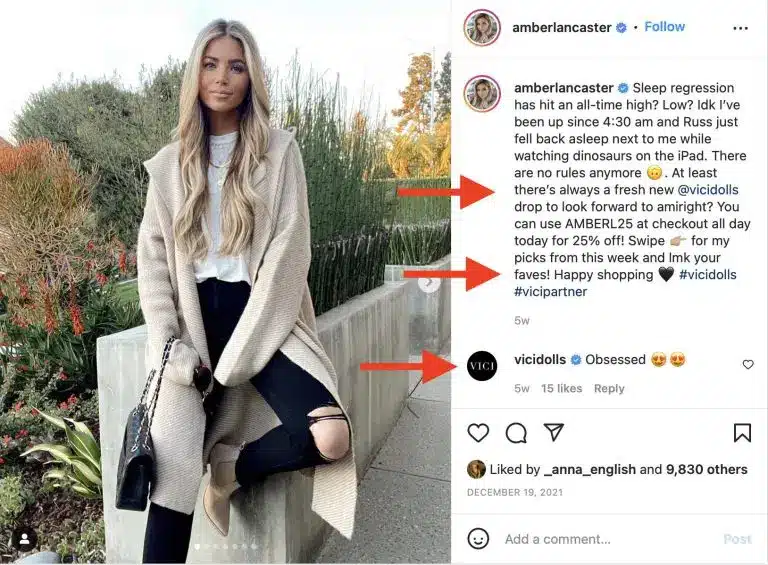
What Makes a Successful Influencer Marketing Campaign?
A successful campaign accomplishes its intended goals and produces positive results. Yet success shouldn’t be measured solely through the eyes of the company. The campaign must also end with a positive outcome for the influencer.
For Brands
- Achieving the campaign objectives: Obviously, this is the top purpose of any marketing activity. Goals will help ensure a coherent campaign message reaches its target audience. Goals provide the framework for the entire effort, from influencer selection and content ideation to market mapping and execution. Measuring and determining the collaboration’s shortcomings and strengths is only possible with them.
- Genuine connection with the audience: The right content creators enable brands to reach an interested audience and authentically engage them, strengthening the relationship between the company and the clients.
- Increased exposure and reach: Having your brand exposed to a large audience is beneficial, but greater visibility leads to increased customer and sales growth, improved brand recognition, and more website traffic. Using the right marketing intelligence tools can help maximize your reach.
- Positive brand sentiments: Businesses can become more human and relatable through creators who agree with the brand’s values. They can create content that speaks directly to the target audience and portrays the brand positively.
For Influencers
- Collaboration opportunity: Influencers learn the ins and outs of brand collaborations through campaigns. It allows them to showcase their creativity, knowledge, and skills within a particular framework. Additionally, they can earn money or access free goods and services.
- Follower growth: With the right partnership and brand, their content can generate a lot of engagement and grow their following.
- Established reputation: By partnering with well-established companies, the brand’s credibility and reputation improve, as does the influencer’s. They can become sought-after thought leaders and authority figures in their fields.
- Content: To stay relevant and competitive, creators must keep their followers’ attention and be constantly active on social media. Luckily, brand partnerships provide them with content ideas.
- Long-term partnerships: A collaboration between a creator and a brand that complements one another is the building block of a long-term relationship. It’s a win-win scenario for both parties.
Let’s examine how to structure an efficient influencer marketing campaign. I have provided a checklist guide below for an easy process.
How Do You Structure an Efficient Influencer Marketing Campaign?
Here’s a comprehensive checklist guide on how to structure an efficient influencer marketing campaign:
How to Create the Best Influencer Marketing Campaigns
Influencers are trusted by the people that follow them. This simple fact is why influencer marketing is the most effective tool today. These trusted messengers are in the perfect position to recommend products. It’s easy to see why more marketers turn to influencer marketing each year.
After checking out our checklist above about structuring influencer marketing campaigns, I see that the six steps to create a successful one seem easy to implement.
#1. Develop the Concept of Your Influencer Campaign
Your strategy depends on what you want to achieve. Do you want to increase social media engagement? Do you want to increase the sales of a product?
Clearly defined goals are the foundation of your strategy and will make the process much easier. Just remember to avoid getting too excited and setting a lot of goals. For your first campaign, it is best to set one targeted goal and build from there. Once your goal is set, determine the KPIs you will use to measure the campaign’s success.
#2. Identify the Influencers That Fit Your Brand and Goals
This may seem complicated, but it isn’t. The goal you set in Step 1 will help you narrow your focus when selecting social media influencers. If you want to maximize reach, then aim for influencers with larger audiences. If sales and conversion are your primary targets, focus on influencers creating content in a relevant niche.
Find influencers by searching for keywords or hashtags related to your brand on your target platform. Keyword searches will reveal the most popular influencers posting relevant content. Make a shortlist of the people who resonate the most with your brand’s message and goals. Those are the people you will focus on for the next steps.
#3. Verify That Your Influencers Are Authentic
Fake influencers—yes, unfortunately, they do exist. We have put together another post to help you figure out exactly how to spot fake influencers, but here are the key points. Always check their profile. You are looking specifically at the quality of content and audience engagement for each influencer. You want to work with someone with high-quality content and an active audience that likes and comments on their posts.
Taking a little time to check the profiles manually will save you from wasting money and time on someone whose entire audience is fake.
#4. Contact and Negotiate Prices
Many influencers interested in working with brands have their email in their profiles’ bio section. If they don’t have an email listed, then send a private message that gets to the point quickly. Your message should briefly describe the campaign and what you expect from them (how many posts, which platforms, etc.).
If they agree to work with you, ask for their analytics. This is technically part of the verification process in Step 3. You want to see the kind of engagement they are getting and their exact demographic data to ensure they reach out to the audience you need to target.
If everything goes well, negotiate the price for creating and delivering the content. 50% of the payment is upfront; the rest is sent after the content is uploaded.
#5. Manage Distribution of Influencer Content
This is the most exciting part. The contract is signed, and it is time for the content to go up. Contact your influencer partners to confirm when the posts have been uploaded. Also, monitor the feedback your post is getting. If something doesn’t work well, you must work with the influencer to address this problem.
#6. Measure Your Influencer Marketing ROI
Remember that goal you set up at the beginning of this process? Now it’s time to see how the campaign met that goal. Look at the relevant KPIs and see what the numbers tell you. Hopefully, it all went well, and you’ve had amazing success.
After creating a successful influencer marketing campaign, the next step is to find ways to improve them.
Ways to Improve Your Influencer Marketing Campaigns
Whether your brand is dipping its toe into the influencer marketing pool or you’re looking to ride the wave into even higher sales this year, there are a few key elements to consider: savvy marketers need to have authentic relationships with their influencers, create efficiencies with campaign management, and realize the growing acceptance of micro-influencers.
Let’s dive in further. Here are 3 tips for running successful influencer marketing campaigns.
#1. Focus on Relationships
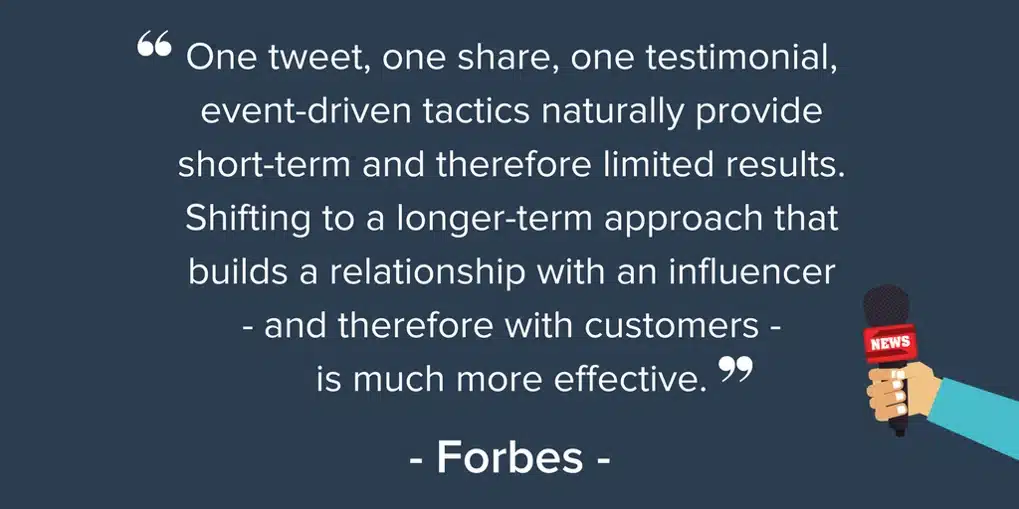
Now is the time for quality over quantity to really matter. The shift towards this more personal marketing approach delivered by influencer marketing has been driven by the increased demand of consumers who want to know that the brands they support not only offer quality products or services but also come recommended.
As influencer marketing becomes ubiquitous, one primary realization has crystallized: it’s not enough to identify and pay influencers for single-post campaigns on just one platform. Not all influencers are created equal, and the best way to ensure a successful campaign is to develop relationships with both paid and organic partners who can employ a multi-platform approach, all while using influencer strategies to augment your brand’s internal multi-channel campaigns.
#2. Leverage Data-driven Influencer Marketing Platforms
Over the past several years, influencer marketing has expanded exponentially. In fact, it is now a $5-10 billion dollar industry. So, it makes sense that this channel drives more interest and investment than ever before.
Like any other marketing initiative, reporting and optimizing is key to understanding the success of your program. Especially now, as influencer marketing is gaining traction and understanding in the C-suite, engagement metrics just won’t cut it.
Brands must partner with a data-driven influencer marketing platform to provide influencers with the necessary tools, track activity and conversions, manage payouts, analyze trends, and measure ROI. The ones that can automate emails, customize share links, and white-label their programs are the brands that will see the most success this year.
#3. Partner With Micro-Influencers and Customers

The exact definition of micro-influencer is still being decided as brands select personas with as little as 1,000 followers all the way up to 200,000 followers to champion their brand’s products or services. But one thing is clear: brands are slowing down in the race for social status and one-time traffic boosts that come from celebrity endorsements and focusing more diligently on relationships that provide conversions.
Higher demand for micro-influencers will also mean an increase in the value of their services. Brands must be more thoughtful and genuine when creating partnerships with influencers. Most importantly, brands must show micro-influencers how they can benefit from a relationship and/or improve their career.
How Do You Know if an Influencer Campaign Is Successful?
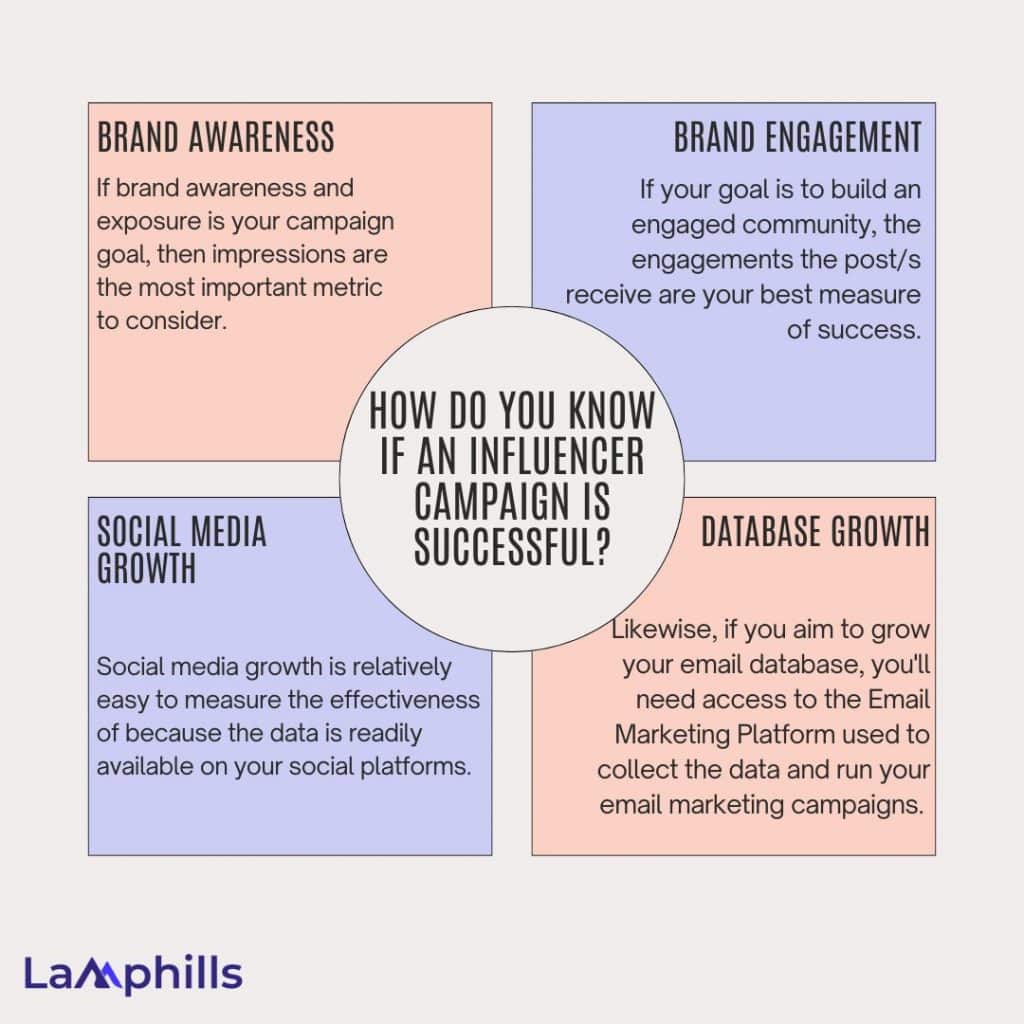
The measure of success for influencer marketing depends on your campaign goals, so it is important to know from the beginning how you will track, measure, and judge campaign effectiveness. So here is a list to know if your influencer marketing campaign is successful or not:
- Brand awareness
- Brand Engagement
- Social media growth
- Database growth.
To explain further:
#1. Brand Awareness
If brand awareness and exposure are your campaign goal, then impressions are the most important metric to consider.
Impressions tell you how many people viewed a piece of content. In influencer marketing, impressions are hard data that tell you exactly how many people were reached due to influencer content about your brand. The more people you can reach, the better it is for brand awareness and exposure.
It’s important to note that impressions don’t mean that someone read and engaged with the content, but merely a metric that tells you the number of eyeballs that saw the piece at any time.
Getting access to impressions is different for each social media or digital channel, and because they are private metrics (i.e., only visible to the influencer), you will need to rely on influencers sending you the data post-campaign. Transparency can come into play here, but we believe that brands should be able to receive this information as part of a working collaboration with an influencer (when monetary compensation is exchanged).
For example, Instagram impression data is only available if the influencer has their profile set to a business account. If so, they can see impressions on each post and send screenshots to the brand. If they don’t, you cannot receive impression data from this influencer.
As another example, Facebook impressions are available to all page owners; the “reach” metric shows how many people the post reached.
Read also: Brand Awareness Ideas: Most Effective Ideas in 2024 (Practical Tips)
#2. Brand Engagement
If your goal is to build an engaged community, the engagement your posts receive are your best measure of success.
Engagements are the likes, comments, shares, retweets, and reactions a piece of content receives. They show how many people were actively engaged with the content, the message, and the brand.
Calculating the number of engagements is relatively easy, as the metrics are all public. You just have to add them together if you work with multiple influencers in one campaign.
For example, influencer 1 may have received 305 likes on an Instagram post and 27 comments, while influencer 2 received 2047 likes and 56 comments. The total engagement for this campaign with influencers 1 and 2 is 2,435. This means that 2,400+ people engaged with the content, which means they stopped, read the post, and consumed it enough to engage with it.
Read more: Brand Engagement: Meaning, Importance & Helpful Tips
#3. Social Media Growth
Social media growth is relatively easy to measure because the data is readily available on your social platforms. You can see and track the growth of your social media followers over time in most built-in social analytics tools or third-party reporting apps. However, you can’t see which influencers you can attribute growth to unless you monitor your social media accounts closely and associate spikes with when influencers post about your brand.
Measuring the effectiveness of influencer marketing intended to drive growth can involve manual reporting and tracking if you want to attribute growth spurts to a particular influencer; otherwise, your social media analytics will give you a clear understanding of overall trends.
If you are measuring this strategy on a client’s behalf, ensure you have admin access to all their social media platforms.
#4. Database Growth
Likewise, if you aim to grow your email database, you’ll need access to the Email Marketing Platform used to collect the data and run your email marketing campaigns. Access to this platform will likely have built-in reporting metrics, which allow you to measure and track database growth and identify engaged users.
To measure the success of a campaign with this goal, you should know how many new email addresses you’d like to collect (a realistic goal) so you can monitor, optimize, and amplify your influencer collaborations to get you closer to achieving the goal.
Influencer Marketing Campaign Examples
Influencer marketing campaigns have become increasingly popular and diverse, spanning various industries and target audiences. Here are some of the diverse influencer marketing campaign examples to illustrate the range of approaches and creativity in this strategy:
#1. Barbie
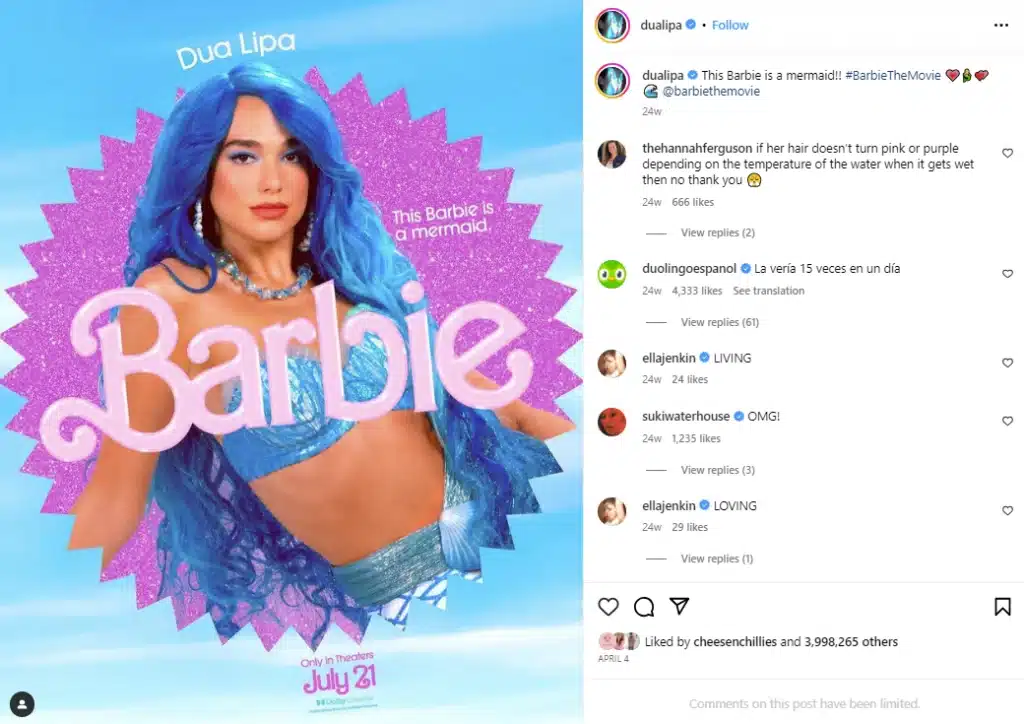
This digital epoch has seen many brands from diverse industries rise and recover from their campaigns; however, Barbie’s movie epitomizes powerful influencer marketing examples.
This movie began its influencer marketing efforts way before the release of the movie. The marketing began with an Instagram campaign featuring all kinds of influencers globally, including celebrity influencers like Dua Lipa, where everyone posted themselves with a unique ‘This Barbie is’ template.
How did this trend erupt? Netizens worldwide contributed to this trend by posting their pictures with this trend, using the movie’s hashtag #BarbieTheMovie, making the campaign a huge success.
Campaign Stats:
- The campaign hashtags #BarbieTheMovie and #BarbieMovie have now crossed over 1.5 million posts on Instagram alone.
- Over 1 million unique users have created content for Barbie.
- This active presence on social media helped the brand generate unmatchable hype for the movie, contributing to its huge hit and making it one of the top-earning movies.
#2. Calvin Klein
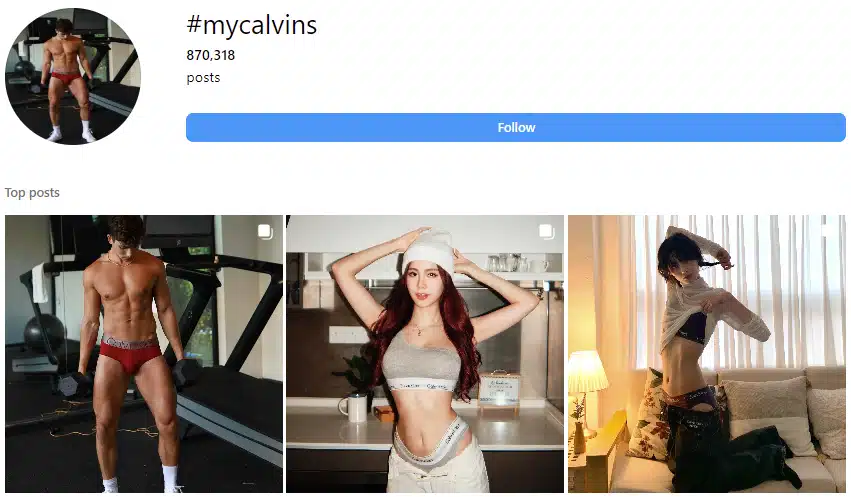
American fashion house and lingerie brand Calvin Klein has repeatedly proven the power of correct influencer marketing. The brand has launched various campaigns over time and leveraged the internet’s power like no other brand has.
From its viral hashtag campaign #MyCalvins that was launched in 2015 (still active) with celebrity influencers like Justin Bieber and Kendall Jenner. The campaign utilized popular social commerce platforms like Instagram and Twitter, where influencers and users would share photos and stories wearing Calvin Klein products, further promoting the #MyCalvins hashtag.
Campaign Stats:
- The campaign #MyCalvins has now crossed over 870K posts on Instagram alone.
- Over 1 million unique users have created content for Calvin Klein.
- This vast number has helped the brand increase its social media engagement rate by 5X.
#3. Daniel Wellington
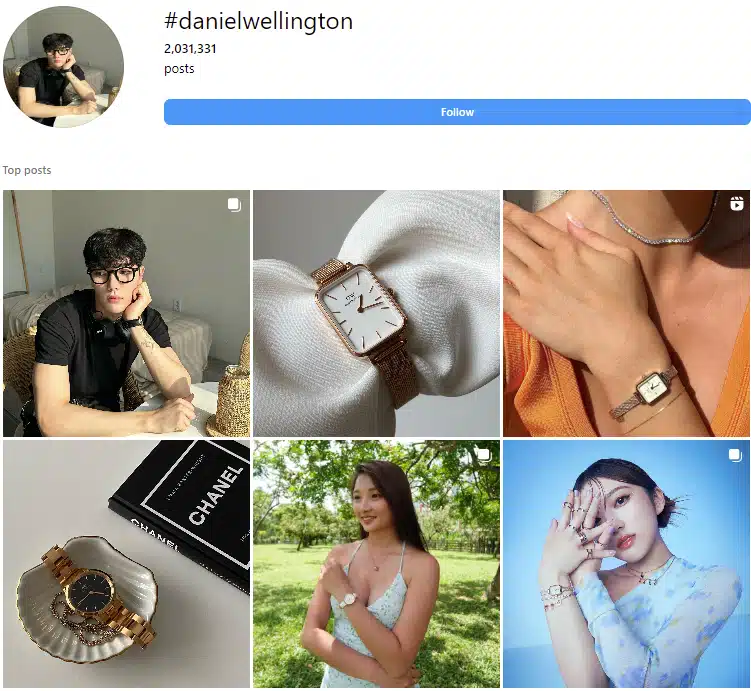
Daniel Wellington is the perfect example of how businesses can improve their ROI through influencer-generated content. This accessory brand started its influencer marketing in mass through micro and nano-influencers.
This strategy resulted in a spike in the number of posts using the brand’s hashtag on social media, helping the brand improve its visibility and awareness considerably.
Campaign Stats:
- Daniel Wellington’s branded hashtag, #danielwellington, has over 2 million posts on Instagram, making it the most popular accessory brand globally.
- The brand has collaborated with over 10,000 content creators globally.
- This active presence on social media helped the brand generate unmatchable brand visibility and awareness.
How Effective Are Influencer Marketing Campaigns?
The truth of influencer marketing’s effectiveness lies in the stats – because these never lie!
Here are some stats and insights pointing to the proficiency of this marketing approach:
- Businesses can make approximately $18 value on every dollar spent on influencer marketing campaigns.
- 93% of marketers have included influencer partnerships in their content marketing strategies.
- 8 out of 10 buyers purchased a product after seeing influencer posts recommending it.
- In contrast to the under 40% of customers who trust brand-created content, 61% of consumers trust influencer suggestions.
- A study showed that influencer marketing ROI was 11x that of banner ads.
- 87% of social media users took a specific action after seeing influencer content on Instagram.
- 49% of shoppers rely on influencers’ recommendations when choosing a product.
How Many Influencers Should I Use for a Campaign?
The thing is, there is no magic number when it comes to how many influencers you should hire. There are too many variables to consider, such as your industry, goals, growth stage, etc. Besides, one of the biggest benefits of influencer marketing is the freedom to scale at your own pace.
But if you have the bandwidth to hire hundreds of influencers, I recommend that.
How Long Should You Run an Influencer Campaign?
First, there’s no magic number for how long influencer marketing campaigns should be.
Like any marketing channel, you must invest long enough to test and optimize before seeing results. Maximum results mean momentum and time. Brands that see legitimate results view influencers as part of their holistic marketing strategy and not a quick blip on the radar.
However, planning and executing a campaign might take several weeks or months.
Bottom Line
Influencer marketing is a passing trend and a strategic necessity for brands aspiring to make a lasting mark in today’s competitive market. It’s a dynamic tool that can lead to a significant shift when harnessed with precision and creativity.
The showcased examples of influencer marketing campaigns and how to create this type of marketing strategy are proof of the undeniable impact of social media and influencer marketing campaigns. They signify that when executed with proper planning, thorough research, and innovative ideation, this strategy can push any brand towards unprecedented growth—popularity, trust, or revenue.
Similar Articles
- How To Find YouTube Influencers for Your Brand: 7+ Proven Ways
- All You Need to Know About Becoming a Successful Marketing Consultant in 2024
- 10 Powerful Content Localization Tips from Top Marketing Experts





